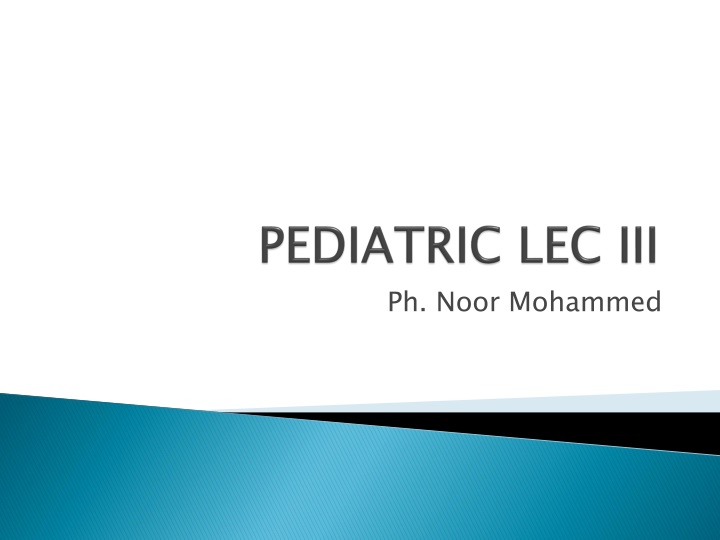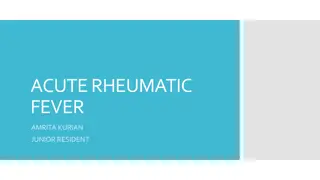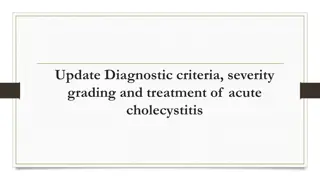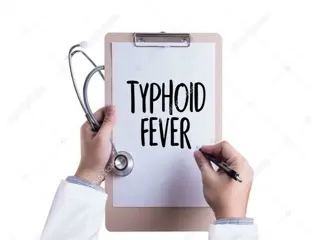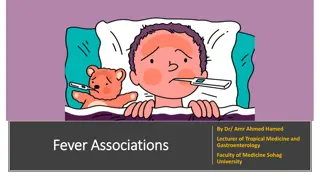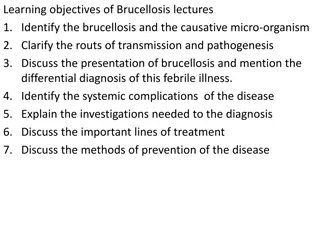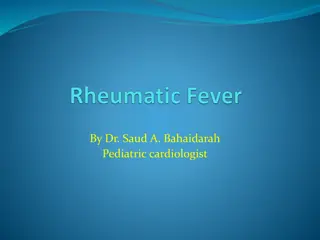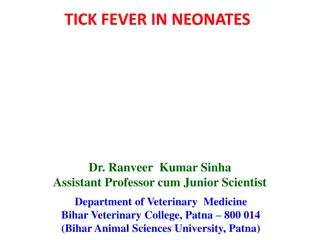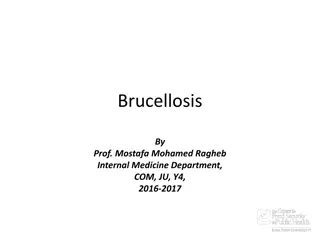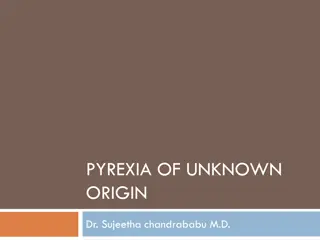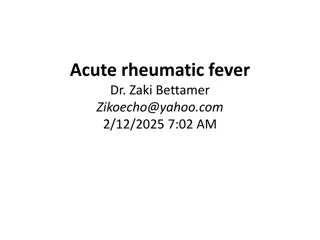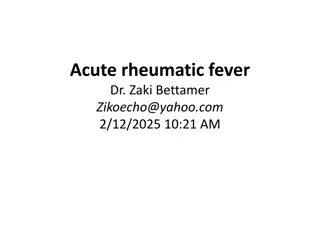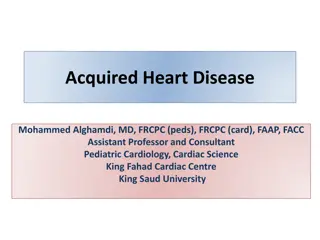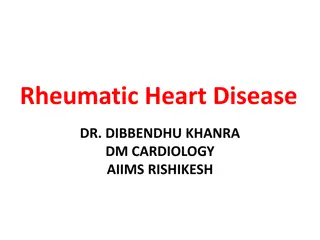Acute Rheumatic Fever: Causes, Diagnosis, and Treatment
Acute rheumatic fever is a multisystem disorder triggered by specific streptococci strains. Learn about its causes, diagnosis criteria, and treatment options including benzyl penicillin, aspirin, and supportive therapies for carditis. Early detection and appropriate management are crucial in preventing long-term cardiac complications.
Download Presentation

Please find below an Image/Link to download the presentation.
The content on the website is provided AS IS for your information and personal use only. It may not be sold, licensed, or shared on other websites without obtaining consent from the author.If you encounter any issues during the download, it is possible that the publisher has removed the file from their server.
You are allowed to download the files provided on this website for personal or commercial use, subject to the condition that they are used lawfully. All files are the property of their respective owners.
The content on the website is provided AS IS for your information and personal use only. It may not be sold, licensed, or shared on other websites without obtaining consent from the author.
E N D
Presentation Transcript
Acute preventable cause of cardiac disease . Acute rheumatic fever usually affects children (most commonly between 5 and 15 years) or young adults. 2-The condition is triggered by an immune-mediated response to infection with specific strains of group A streptococci, which have antigens that may cross-react with cardiac myosin and membrane protein. Antibodies produced against the streptococcal antigens cause inflammation in the heart as well as the joints and skin rheumatic fever remains an important
Acute rheumatic fever is a multisystem disorder that usually presents with fever, and joint pain, 2 6 weeks after an episode of streptococcal pharyngitis. 2-The presence of either two major criteria or one major and two minor criteria, along with evidence of preceding streptococcal infection, confirm a diagnosis of acute rheumatic fever. antibody antistreptolysin O (ASO) titer, are the most reliable laboratory evidence of prior infection]. [Streptococcal tests, such as the
A single dose of benzyl penicillin 1.2 million U i.m. or oral phenoxymethyl penicillin for 10 days should be given on diagnosis to eliminate any residual streptococcal infection. Bed rest is important, as it lessens joint pain and reduces cardiac workload.
Aspirin: This will usually relieve the symptoms of arthritis rapidly. The usual dose of aspirin is 100 mg/kg/24 hr divided qid PO for 3-5 days, followed by 75 mg/kg/24 hr divided qid PO for 4 wk. 4-Patients with carditis and cardiomegaly or congestive heart failure should receive corticosteroids. The usual dose of prednisone is 2 mg/kg/24 hr in 4 divided doses for 2-3 wk followed by a tapering of the dose that reduces the dose by 5 mg/24 hr every 2-3 days.
Supportive therapies for patients with moderate-to- severe carditis include digoxin, fluid and salt restriction, diuretics, and oxygen
There are six primary hepatitis viruses: Hepatitis A virus (HAV), Hepatitis B virus (HBV), Hepatitis C virus (HCV), Hepatitis D virus (HDV), Hepatitis E virus (HEV) and Hepatitis G virus (HGV)
HAV HAV HBV HBV HCV HCV HDV HDV HEV HEV HGV HGV Transmissi on Transmissi on Fecal -oral Transfusi on, sexual, perinatal Parentera l, transfusi on, perinatal Simila r HBV Fecal -oral Parenter al transfusi on to
Asymptomatic or mild, nonspecific illness without icterus (jaundice) is common with HAV, HBV, and HCV, especially in young children. The preicteric phase, which lasts approximately 1 week, is characterized by headache, anorexia, malaise, abdominal discomfort, nausea, and vomiting and usually precedes the onset of clinically detectable disease. 3-Jaundice and tender hepatomegaly are the most common physical findings and are characteristic of the icteric phase. Hepatic enzymes may increase 15- to 20- fold.
Most cases of acute viral hepatitis resolve without specific therapy, with less than 0.1% of cases progressing to fulminant hepatic necrosis which is associated with a high mortality rate HAV and HEV cause acute infection only. HBV, HCV, and HDV may persist as chronic infection with chronic inflammation, fibrosis, and cirrhosis and the associated risk of hepatocellular carcinoma .
The diagnosis of viral hepatitis is confirmed by serologic testing. Treatment The treatment of acute hepatitis largely supportive and involves rest, hydration, and adequate nutrition. Hospitalization is indicated for severe cases Chronic HBV infection may be treated with interferon alfa-2b or lamivudine, and HCV may be treated with interferon alfa usually in combination with Ribavirin (1)(except HCV (3)) is
is an autosomal recessive multisystem disorder caused by mutations in the cystic fibrosis transmembrane regulator (CFTR). CFTR is important for the proper movement of salt and water across epithelial cell membranes especially in the airways, liver, and pancreas . The term cystic fibrosis arises from the fibrotic scar tissue that replaces the destroyed pancreas
CF is most commonly diagnosed on the basis of typical signs and symptoms and an abnormal sweat chloride concentration (>60 mEq/L) ( sweat chloride test)
GI system 1. protease, and amylase) is the mainstay of gastrointestinal therapy . 2. Fat-soluble vitamins supplementation is usually insufficiency. 3. The use ursodeoxycholic acid (UDCA) may improves bile flow, prevent obstruction and slow progression of liver disease Pancreatic enzyme replacement (lipase, (A, required D, E, in and pancreatic K)
Treatment of cystic fibrosis airway disease: Mucociliary Clearance A-Physical Therapy: Airway clearance can be performed using various techniques. These techniques are recommended on a daily basis to help mobilize secretions. B-Mucolytic Therapy: Sputum viscosity is increased by the large quantities of extracellular DNA that result from chronic airway inflammation and degradation of neutrophils. Inhaled recombinant human deoxyribonuclease extracellular DNAin sputum. C-Airway Hydration Therapies : Inhalation of hypertonic saline rehydrates the airways through osmotic flow of water. D-Bronchodilators: -Agonists keep airways open and facilitate airway clearance. Treatment of cystic fibrosis airway disease: cleaves
Antibiotics: Antibiotics are used to treat lung infection. Typical regimens for severe antipseudomonal -lactam plus an aminoglycoside for added synergy and delay of resistance development. Fluoroquinolone use is common among CF patients infected with P. aeruginosa, even in children. Chronic maintenance antibiotic therapy may be used in patients with Pseudomonas colonization in an attempt to prevent bacterial overgrowth. Inhaled tobramycin has been studied the most extensively infections include an
Diabetic ketoacidosis (DKA) Definition: Arterial pH <7.30, bicarbonate <15 meq/L, glucose >250 mg/dL, and Urinary ketones. DKA is a major medical emergency and remains a serious cause of morbidity, principally in people with type 1 diabetes (More common in type 1 DM but can occur in type 2 DM)
The hyperglycaemia causes a profound osmotic diuresis leading to dehydration, hyperosmolarity, and electrolyte loss, particularly of sodium and potassium. Owing to increased lipolysis and decreased lipogenesis, free fatty acids are converted to ketone bodies and lead to metabolic acidosis. Electrolyte abnormalities occur through a loss of electrolytes in the urine(7). In addition, The resulting metabolic acidosis causes efflux of potassium from cells, results in intracellular potassium depletion
Patients with DKA present initially with polyuria, polydipsia, nausea, and vomiting. Abdominal pain occurs frequently. 2-Respiratory compensation for acidosis results in tachypnea with deep (K ssmaul) respirations. The fruity odor of acetone frequently can be detected on the patient s breath. 3-An altered mental status can occur, ranging from disorientation to coma
DKA is a medical emergency which should be treated in hospital. The principal components of treatment are : The administration of short-acting (soluble) insulin. Fluid replacement. Potassium replacement. The administration of antibiotics if infection is present. Note: for more detailed about for the management of ketoacidosis , there is a Diabetic Ketoacidosis Treatment Protocol. Complications The most concerning complication of DKA is cerebral oedema (Treatment by Mannitol 1 g/kg IV)
